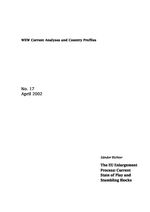The EU Enlargement Process: Current State of Play and Stumbling Blocks
In this paper an attempt is made to estimate the balance between transfers from and contributions to the EU budget by the new members of the EU in the first three years after enlargement upon the assumption that the date of accession will be 2004; the number of acceding countries is ten (all candidate countries, except Bulgaria and Romania). Key figures from the Commission's communication released on 30 January this year served as reference for calculations concerning transfers and contributions of the new members. Their net financial position will, however, eventually depend on the rate of success they may be able to attain in turning available resources into disbursed transfers. According to the author's optimistic scenario, new members will be able to obtain about three quarters of the resources available. That roughly corresponds to the success rates attained by present EU members in the recent past in the case of structural supports. According to the pessimistic scenario the rate would be 50% reflecting the respective rates of the worst performing EU members in receiving transfers from the Structural Funds. Finally, a worst-case scenario with 30% success rate was elaborated. That is based on disappointing experiences with pre-accession aid in some candidate countries.
The outcome of the computations shows that according to both the optimistic and pessimistic scenarios, the first year of membership will most likely see the new members assuming a net contributor position. The relative significance of the net financial position measured as a percentage of the new members' GDP is surprisingly low. It is less than 1% each year according to both scenarios, except in the optimistic scenario for 2006 when it amounts to 1.06%.
Keywords: EU enlargement, financial framework, transfers, net financial position, agriculture, budget, regional policy, accession negotiations, acquis communautaire, pre-accession aid
JEL classification: F15, F35, F36, Q17, Q18
Countries covered: New EU Member States
